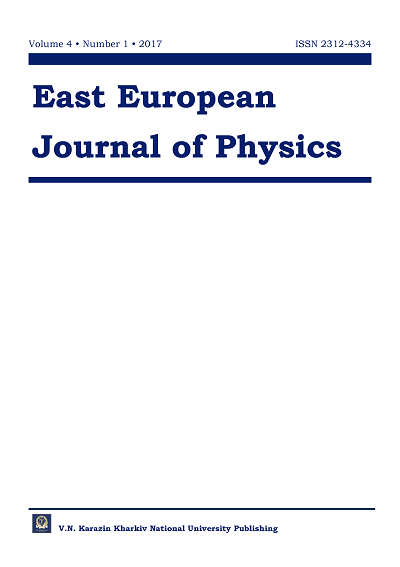THE LATTICE PARAMETERS AND RESIDUAL STRESSES IN BULK NANOCRYSTALLINE AND ULTRAFINE-GRAINED TITANIUM
Abstract
Lattice parameters and residual stresses in the bulk nanocrystalline/ultrafine-grained titanium were studied by X-ray diffraction methods. The investigated samples were prepared using the method of the cryomechanical grain structure fragmentation with multiple rolling at the temperature of liquid nitrogen to the true strain value |e| = 3. Phasic change of the a and c parameters has been found with increasing degree of cryoreduction. This change was stronger for the parameter a. The observed change parameters associated with a relative slip and twinning activity (initial cryo-reduction stage) as well as the formation of the nanocrystalline state (at higher degree of deformation). The most likely source of residual stresses arising in titanium at cryorolling is heterogeneous plastic deformation. The production of nanocrystalline / ultrafine-grained titanium using cryomechanical grain fragmentation method is accompanied by the formation of uniform compressive residual stresses in the informative deformable layer of billet.
Downloads
References
2. Kutniy K.V., Volchok O.I., Kislyak I.F., Tikhonovsky M.A., Storozhilov G.E. Obtaining of pure nanostructured titanium for medicine by severe deformation at cryogenic temperatures // Mater. Sci. and Eng. Technolog. – 2011. – Vol. 42. – No. 2. – P. 114-117.
3. Moskalenko V.A., Smirnov A.R., Moskalenko A.V. Cryomechanically obtained nanocrystalline titanium: microstructure and mechanical mechanical properties // Low Temp. Phys. – 2009. – Vol. 35. – P.905-907.
4. Plotnikova Yu.M., Braude I.S., Moskalenko V.A. X-ray parameters of a nanocrystalline titanium microstructure, obtained via cryodeformation // Low Temp. Phys. – 2016. – Vol. 42. – P. 1175–1180.
5. Moskalenko V.A., Smirnov A.R., Smolianets R.V. Low-temperature plastic deformation and strain-hardening of nanocrystalline titanium // Low Temp. Phys. - 2014. – Vol. 40. – P. 837–845.
6. Birger I.A. Ostatochnyye napryazheniya [Residual stresses]. – M.: Mashgiz, 1963. – 232p. (In Russian)
7. Wroński M., Wierzbanowski K., Wrуbel M., Wroński S., Bacroix B. Effect of rolling asymmetry on selected properties of Grade 2 // Met. Mater. Int. – 2015. – Vol. 21. – No. 5. – P. 805-814.
8. Noyan I.C., Cohen J.B. An X-ray diffraction study of the residual stress-strain distributions in shot-peened two-phase brass // Mater. Sci. Eng. – 1985. – Vol. 75. – P. 179-193.
9. De los Rios E.R., Walley A., Milan M.T., Hammersley G. Fatigue crack initiation and propagation on shot-peened surfaces in A316 stainless steel // Int. J. Fatigue. – 1995. – Vol. 17. – P. 493–499.
10. Wu T., Hartley C.S., Wang X.M., Tsai C.T. Residual stress distribution in cold rolled brass sheet // J. Mater. Process. Technol. – 1994. – Vol. 45. – P. 111-116.
11. Gladkikh L.I., Malykhin S.V., Pugachev A.T. Difraktsionnyye metody analiza vnutrennikh napryazheniy. Teoriya i eksperiment: Ucheb. Posobiye [Diffraction methods for analysis of internal stresses. Theory and experiment: Handbook]. - Khar'kov: NTU «KHPI», 2006. – 304p. (In Russian)
12. Tsvikker U. Titan i yego splavy [Titanium and its alloys]. – Moskva: Metallurgiya, 1979. – 512p. (In Russian)
13. Friedel J. Dislocations. – Moskva: Mir, 1967. – 600 s.
14. Moskalenko V.A., Betekhtin V.I., Kardashev B.K., Kadomtsev A.G., Smirnov A.R., Smolyanets R.V., Narykova V.V. Mechanical properties and Structures of Nanocrystalline titanium produced by cryorolling // Physics Solid State. – 2014. – Vol. 56. – No. 81. – P. 1590-1596.
15. Zhu Y.T., Liao X.Z., Wu X.L. Deformation twinning in nanocrystalline materials // Prog. Mater. Sci. - 2012. - Vol. 57. - P. 1-62.
16. Tablicy fizigheskih velichin [Tables of physical quantities.]. Ed. Akad. I.К. Кikoin. - М.: Аtomizdat, 1976. – 1008p. (in Russian)
17. Moskalenko V.A., Smirnov A.R., Smolianets R.V. Low-temperature plastic deformation and strain-hardening of nanocrystalline titanium // Low Temp. Phys. - 2014. – Vol. 40. - P.837 - 845.
Authors who publish with this journal agree to the following terms:
- Authors retain copyright and grant the journal right of first publication with the work simultaneously licensed under a Creative Commons Attribution License that allows others to share the work with an acknowledgment of the work's authorship and initial publication in this journal.
- Authors are able to enter into separate, additional contractual arrangements for the non-exclusive distribution of the journal's published version of the work (e.g., post it to an institutional repository or publish it in a book), with an acknowledgment of its initial publication in this journal.
- Authors are permitted and encouraged to post their work online (e.g., in institutional repositories or on their website) prior to and during the submission process, as it can lead to productive exchanges, as well as earlier and greater citation of published work (See The Effect of Open Access).








